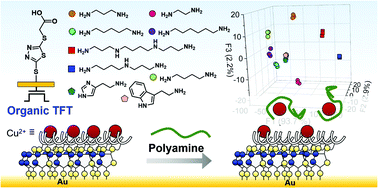Detection of polyamines by an extended gate-type organic transistor functionalized with a carboxylate attached 1,3,4-thiadiazole derivative†
Abstract
We herein report an extended gate-type organic thin-film transistor (OTFT)-based polyamine sensor and its application in pattern recognition. The extended-gate electrode was functionalized with a complex of copper(II) ions and 2-carboxymethylthio-5-mercapto-1,3,4-thiadiazole, which enabled the OTFT to respond to polyamines in an aqueous solution. Moreover, the responses of the OTFT-based sensor exhibited a cross-reactivity, implying its capability to detect multi-analytes. Thus, we performed pattern recognition against nine target polyamines (spermine, spermidine, trimethylenediamine, ethylenediamine, histamine, tryptamine, putrescine, cadaverine and 1,6-diaminohexane) in combination with linear discriminant analysis and successfully discriminated the analytes. Moreover, we achieved the quantification of spermine in a diluted fruit juice by using a support vector machine with high accuracy. Overall, the demonstration using the OTFT-based chemical sensor with pattern recognition revealed its potential for sensing polyamines in real samples.

- This article is part of the themed collection: Journal of Materials Chemistry C Emerging Investigators


 Please wait while we load your content...
Please wait while we load your content...